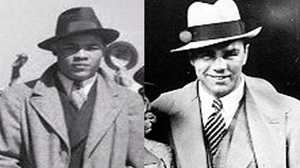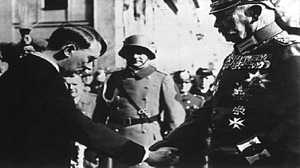The Louis-Schmeling Fights, 1936 and 1938

Joe Louis was the 10-to-1 favorite over the German boxer Max Schmeling before their first bout on June 19, 1936. Each man was fighting for a shot at the world heavyweight boxing championship.
Expectations
The two fighters appeared to be on different trajectories. Louis's career had been a meteoric rise to the top. Just two more fights and he would be world heavyweight champion. Schmeling had been at the top, winning and losing the title controversially. In 1930, Jack Sharkey had hit Schmeling below the belt and was disqualified, giving the German the title. Schmeling fought Sharkey again in 1932, and most boxing authorities were surprised when Sharkey won on decision.
Knockouts vs. Decisions
Physically, Louis and Schmeling were a close match, but they entered the ring with different strategies. They were within a half inch in height. They both had a 76-inch arm reach. Louis, at age 22, was a natural talent, strong and quick with an amazing ability to take a punch. Schmeling would turn 31 that year; he still had a powerful right fist but had a more cautious approach in the ring. Most of Louis's wins came on knockouts. Schmeling often won on decisions, learning about his opponents in the first rounds and then wearing them down.
Schmeling's Homework
Schmeling prepared well for the 1936 fight, both psychologically -- trying to dispel the "Joe Louis myth" that had defeated other boxers before they stepped into the ring -- and strategically -- studying hours of film of Louis's boxing style. Schmeling watched the films backwards and forwards, literally. Watching Louis so carefully helped Schmeling to recognize a pattern in Louis's punches and thus gave him a split second of anticipation. He also noticed that for the tiniest moment between lefts, Louis often dropped his guard. Schmeling came to believe that, if he could stand close enough, taking the punishment from Louis's fists, he would occasionally have a chance to deliver his right, the best weapon in Schmeling's arsenal. "Louis's one weakness matched perfectly my greatest strength, the one with which I had made my career," the German would later write. "Louis and I were, so to say, 'made for each other.'"
Louis's Overconfidence
Louis, meanwhile, went to Hollywood to play a boxer in a movie, Spirit of Youth. Still a newlywed, he spent time with his wife, and with other women. "Other girls were coming around like flies," Louis recalled. "One time Chappie [Blackburn, his trainer] actually took a stick and threatened them. I found them anyway." Louis lacked focus: he overate and undertrained. He took time off to golf. His managers worried that he was losing too much weight.
Knockout
Like Louis, fight fans assumed Schmeling would be another easy mark. Only 45,000 showed up at Yankee Stadium. The fight went as Schmeling planned. When he saw his opening in the second round, he struck hard. Louis managed to stay in the ring for ten more rounds before the first knockout of his career.
Devastating Blow
For Louis, it was much more than a defeat on the canvas. The young boxer had become a symbol of enormous pride among African Americans, since he had taken on whites at their own game and triumphed. Louis's loss was a devastating blow to the black community. The black press lambasted Louis for letting them down.
Superior Race
Schmeling returned to Germany a national hero. Although the boxer did not join or support the Nazi Party, Adolf Hitler and his propaganda minister Joseph Goebbels found a willing public relations tool in Schmeling. Goebbels manufactured quotes for the fighter, who pronounced himself a member of a superior race.
Heavyweight Title
Despite the win, Schmeling was unable to arrange a title fight with James J. Braddock, the American who wore the heavyweight crown. Adolf Hitler's increasingly threatening regime made the possibility of losing the championship to Germany unpalatable to American fans, so Schmeling's attempts to fight were blocked. The matchup — and title — went to Louis in 1937.
Rematch
Although Braddock would not fight Schmeling, Louis needed to beat the German to make his title definitive. The Louis-Schmeling rematch, on June 22, 1938, again at Yankee Stadium, took place before a sellout crowd of 70,000.
Fighting for Their Nations
The two boxers' second meeting carried heavy political significance. Schmeling represented a government that he did not support, but Louis was comfortable taking on the mantle of the American people. "Here I was, a black man," he would recall. "I had the burden of representing all America. They tell me I was responsible for a lot of change in race relations in America... White Americans -- even while some of them still were lynching black people in the South — were depending on me to K.O. Germany."
Quick Bout
The second fight went quickly. Louis pummeled Schmeling in the first round and knocked him out. The German went down so quickly that the president of the New York Boxing Commission visited him in the hospital to determine whether he had faked his injuries and thrown the fight. This clearly wasn't the case. Americans celebrated Louis's victory with wild abandon. And for Joe Louis, it was a personal and racial redemption. Schmeling returned to Germany, where he disappeared from public life.
Decisive Moments for Both Men
The two Louis-Schmeling fights were the highest and lowest points of both boxers' careers. Schmeling, disappointed with the way he won his earlier championship match against Sharkey, could celebrate his upset victory over Louis without reservation. Louis had never been knocked down in a professional fight, never mind knocked out, and his loss was a painful learning experience and motivator for future fights. In the second match, Schmeling sustained terrible injuries and the Louis fight was his last appearance on the world boxing stage. Louis, for his part, felt his title win over Braddock was hollow without beating Schmeling; the victory over Schmeling was when he truly considered himself world champion.







